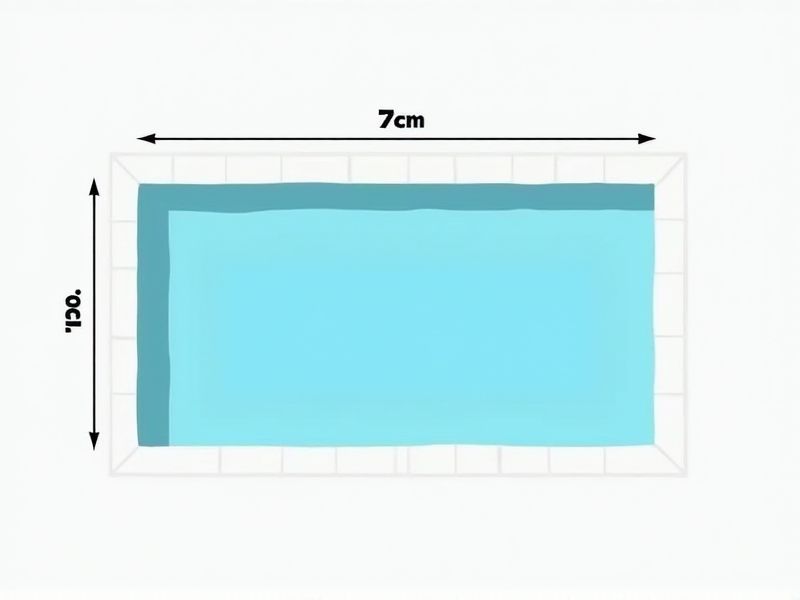
The standard dimensions of an Olympic swimming pool are carefully regulated to ensure fairness and consistency in competitions. An Olympic pool measures 50 meters in length, 25 meters in width, and has a minimum depth of 2 meters throughout. There are 10 lanes, each 2.5 meters wide, with lane ropes to prevent waves from interfering with swimmers. These precise measurements help athletes compete on a level playing field and make record-setting performances comparable across the world.
Length 50 Meters
An Olympic swimming pool must adhere to a precise length of 50 meters, which is a key specification for competitive events. The width is uniformly set at 25 meters, containing at least eight lanes, each measuring 2.5 meters wide. The pool depth must be a minimum of 2 meters to accommodate various swimming techniques and to ensure athlete safety. This standardization allows for fair competition and optimal performance during international events recognized by the International Swimming Federation (FINA).
Width 25 Meters
An Olympic swimming pool measures a standard width of 25 meters, designed to accommodate multiple lanes for competitive swimming. This width allows for up to 10 lanes, each typically 2.5 meters wide, providing ample space for swimmers to compete efficiently. The pool depth is at least 2 meters, ensuring safety and optimal conditions for both performance and technique. You'll find that these specifications adhere to the regulations set by the International Swimming Federation (FINA) for official competitions.
Depth Minimum 2 Meters
The standard Olympic swimming pool requires a minimum depth of 2 meters to ensure the safety and performance of athletes during competitions. This depth helps to reduce wave turbulence, allowing swimmers to achieve their maximum speed and efficiency. Olympic pools also measure 50 meters in length and 25 meters in width, adhering to FINA regulations. Investing in a pool that meets these specifications guarantees a world-class environment for your aquatic events.
Lanes 8 Or 10
An Olympic swimming pool, measuring 50 meters in length and 25 meters in width, typically features 8 or 10 lanes, each 2.5 meters wide. Lanes 1 and 8 are often perceived as less favorable due to irregular currents and wave disturbances, while lanes 4 and 5, positioned centrally, are preferred by elite swimmers for optimal performance. The standard pool depth is at least 2 meters, reducing turbulence and allowing for faster swim times. If you're training or competing, choosing a lane closer to the middle can significantly impact your performance and time efficiency.
Lane Width 2.5 Meters
An Olympic swimming pool adheres to precise standards, featuring a lane width of 2.5 meters, which promotes fair competition and optimal performance. The total length of an Olympic pool is 50 meters, divided into eight lanes, allowing swimmers ample space to maneuver during races. This configuration not only facilitates individual speed but also minimizes wave disturbance from adjacent lanes. Ensuring this standard enables both amateur and elite athletes to compete under uniform conditions, enhancing the integrity of the sport.
Volume Approx. 2.5 Million Liters
An Olympic swimming pool must adhere to specific standards, measuring 50 meters in length and 25 meters in width, resulting in a total volume of approximately 2.5 million liters. This substantial capacity is essential for accommodating competitive swimming events and ensuring optimal conditions for athletes. The pool features a minimum depth of 2 meters to minimize wave interference, allowing for faster swim times. You'll find that these pools are often equipped with advanced filtration systems, maintaining water quality and temperature for peak performance.
Water Temperature 25-28 Degrees Celsius
The standard water temperature for an Olympic swimming pool ranges between 25 to 28 degrees Celsius, creating an optimal environment for athletes. Maintaining this temperature ensures that swimmers can achieve peak performance without excessive strain on their bodies. A consistent temperature within this range also helps in minimizing the risk of muscle cramps and fatigue during rigorous training and competition. Proper temperature regulation is crucial for your comfort and success in swimming events.
Starting Blocks At Each Lane
An Olympic swimming pool measures 50 meters in length and is 25 meters wide, featuring eight lanes that are each 2.5 meters wide. At the beginning of each lane, you'll find state-of-the-art starting blocks designed to enhance your launch into the water, typically elevated to a height of 0.5 meters. In a competitive environment, these blocks include a non-slip surface and adjustable height features, ensuring optimal performance for swimmers. The specifications of starting blocks are crucial for maintaining standards set by the International Swimming Federation (FINA), allowing athletes to achieve their best times.
Touchpads At Both Ends
An Olympic swimming pool measures 50 meters in length and 25 meters in width, with a minimum depth of 2 meters to enhance safety and performance. Touchpads are installed at both ends of the pool, playing a crucial role in timing and race results by accurately capturing swimmers' finishing times. These electronic devices are designed to detect when a swimmer completes their race, ensuring precise digital data is recorded for each athlete. By integrating touchpads, the competition adheres to the stringent standards set by the International Swimming Federation (FINA), promoting fairness and accuracy in elite swimming events.
Underwater Marking Lines
The standard Olympic swimming pool measures 50 meters in length and 25 meters in width, accommodating competitions in both long-distance and short-distance swimming events. Underwater marking lines, typically colored in blue or black, provide swimmers with visual guidance, enhancing their ability to align with lane boundaries during races. These lines are situated 5 meters apart and are crucial for optimizing performance, allowing athletes to maintain their course without surfacing. Proper maintenance of these markings is essential to ensure safety and adhere to the regulations set forth by the International Swimming Federation (FINA).
